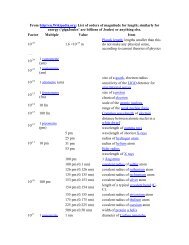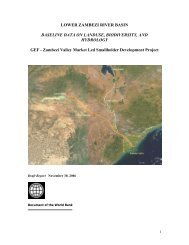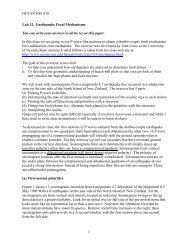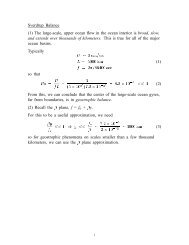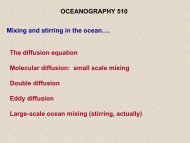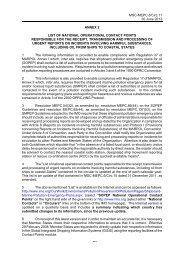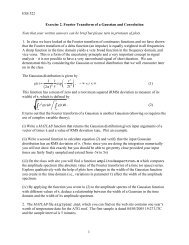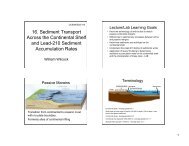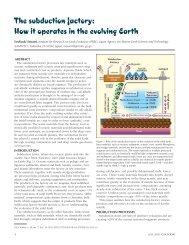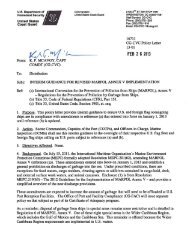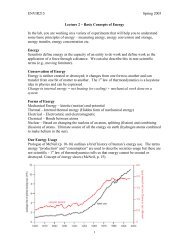2012 Seafloor Geodesy in Cascadia - William Wilcock - University of ...
2012 Seafloor Geodesy in Cascadia - William Wilcock - University of ...
2012 Seafloor Geodesy in Cascadia - William Wilcock - University of ...
You also want an ePaper? Increase the reach of your titles
YUMPU automatically turns print PDFs into web optimized ePapers that Google loves.
When the megathrust fails, seafloor geodetic observations will constra<strong>in</strong> the co-‐ and <br />
post-‐seismic slip and deformation, which will provide important constra<strong>in</strong>ts on mantle <br />
rheology (Wang et al., <strong>2012</strong>). To the west <strong>of</strong> the trench, flexural stresses are released by <br />
outer rise earthquakes (Clouard et al., 2007). The oceanic plate undergoes <strong>in</strong>ternal <br />
deformation as it is flexed and pulled to the east. Some <strong>of</strong> this deformation is <br />
accommodated by <strong>in</strong>traplate earthquakes along <strong>in</strong>herent weaknesses and fracture zones. <br />
External driv<strong>in</strong>g forces from the trench or ridge transmit across the plate (Fox et al., 1999) <br />
and trigger far-‐field events or drive transient deformation from viscous coupl<strong>in</strong>g with the <br />
underly<strong>in</strong>g mantle. F<strong>in</strong>ally, any <strong>of</strong>fshore geodetic array is likely to discover unanticipated <br />
deformation sources. Some examples might <strong>in</strong>clude premonitory slip on the megathrust <br />
(Kato et al., <strong>2012</strong>), poroelastic deformation <strong>of</strong> the prism from fluid flux (Ranero et al., 2008) <br />
or the dissociation <strong>of</strong> gas hydrates, and bas<strong>in</strong> subsidence <strong>of</strong> the cont<strong>in</strong>ental shelf from the <br />
compaction <strong>of</strong> sediment or subduction erosion. <br />
Figure 4. Coseismic displace-ment<br />
and fault slip <strong>of</strong> the To-hoku-‐Oki<br />
magnitude 9 earth-quake<br />
based on model<strong>in</strong>g on-shore<br />
GPS and seafloor GPS-acoustic<br />
observations (from <br />
Newman, 2011 with seafloor <br />
observations based on Sato et al., <br />
2011) <br />
The importance <strong>of</strong> geodetic observations <strong>in</strong> subduction zones was clearly illustrated by <br />
the 2011 magnitude 9.0 Tohoku-‐Oki earthquake <strong>in</strong> Japan (Figure 4). Here an extensive <br />
network <strong>of</strong> GPS stations on-‐land would, if used <strong>in</strong> real time, have easily constra<strong>in</strong>ed the full <br />
magnitude <strong>of</strong> the event with<strong>in</strong> 1-‐2 m<strong>in</strong>utes. Instead, exist<strong>in</strong>g systems us<strong>in</strong>g only seismic <br />
monitor<strong>in</strong>g required ~20 m<strong>in</strong>utes. The Tohoku earthquake occurred <strong>in</strong> a region where <br />
there were also a significant number <strong>of</strong> seafloor geodetic observations above the rupture <br />
zone. Repeat GPS-‐Acoustic fixes documented the deformation and subsequent restoration <br />
<strong>of</strong> <strong>in</strong>terplate coupl<strong>in</strong>g associated with an magnitude 7.2 thrust earthquake <strong>in</strong> 2005 and <br />
show that the co-‐seismic slip associated with 2011 earthquake exceeded 50 m near the <br />
trench, about twice that <strong>in</strong>ferred from model<strong>in</strong>g data on land. If this data had been <br />
available <strong>in</strong> real time for the 2011 earthquake it would have decreased even further the <br />
time necessary to acquire the data to constra<strong>in</strong> the size <strong>of</strong> the event. Ocean bottom <br />
pressure time series on autonomous <strong>in</strong>struments recorded vertical seafloor movements <br />
9



